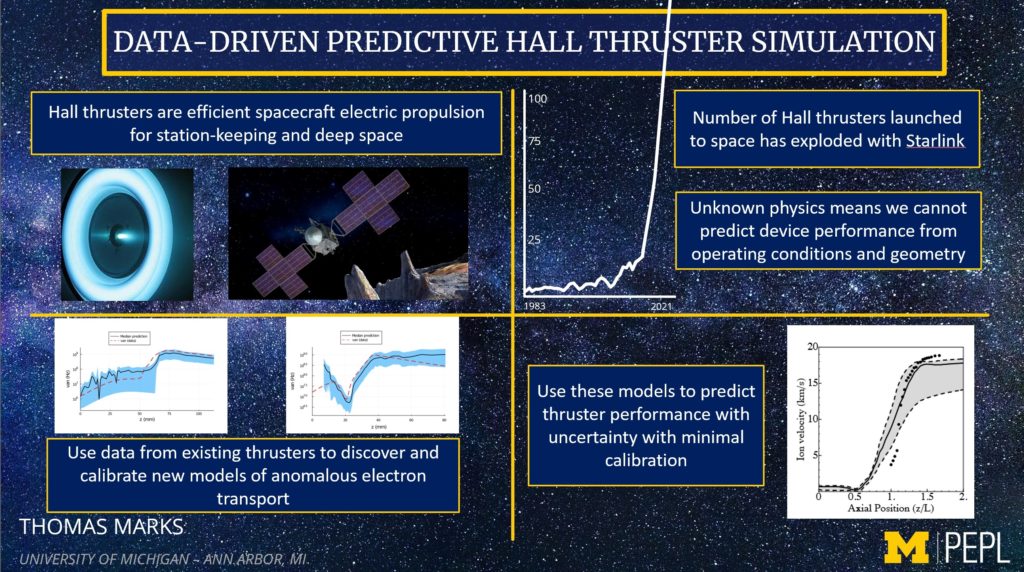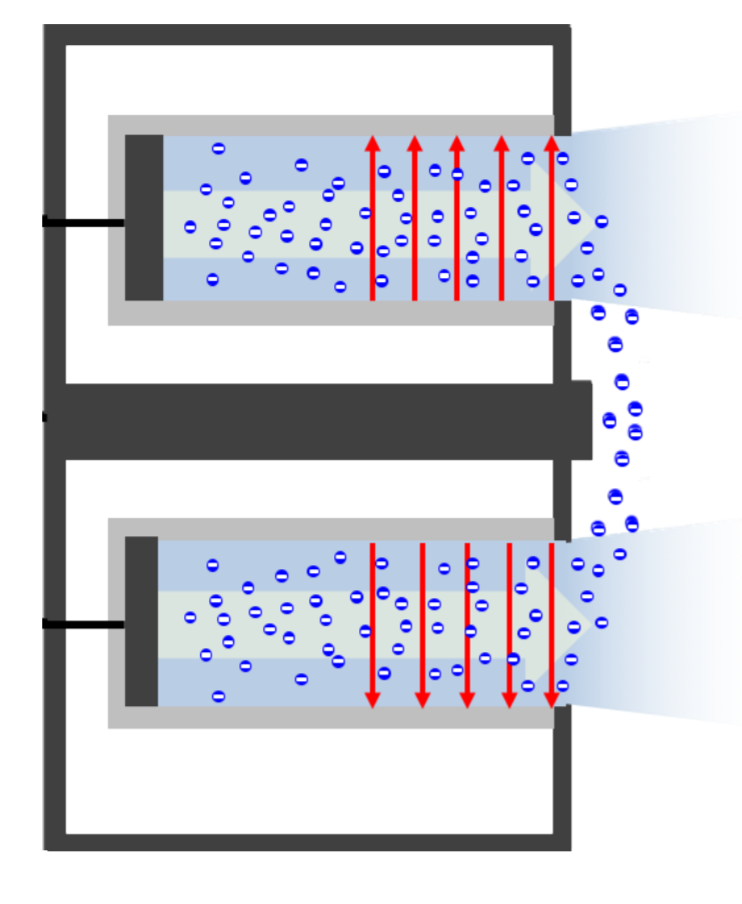Project
Data-Driven Predictive Modeling
project personnel
Matthew Byrne, Joshua Woods, Pete Dahl, Thomas Marks, Benjamin Jorns
Principal Investigator
Benjamin Jorns
project sponsors
AFOSR
Current computational models of many electric propulsion (EP) devices are hampered by insufficient understanding of the underlying physics. Most prominently, current models are unable to capture the well-known problem of enhanced anomalous transport of electrons across magnetic field lines in Hall thrusters. Recent work suggests that kinetic effects are likely to play a large role in cross-field electron transport. However, fully-kinetic models are computationally expensive, so there is an incentive to make use of comparably inexpensive fluid models, despite their inherently reduced fidelity. If sufficiently-predictive fluid models for electric propulsion devices were available, they would enable rapid design iteration and reduce the cost of developing and qualifying EP systems by decreasing the number of expensive, long-duration ground tests. They would enable institutions to experiment with novel electric propulsion concepts with increased confidence in their on-orbit performance. If ground-to-flight performance changes became reliably predictable, even to a first order, thruster lifetime, thrust, and efficiency could be better optimized for in-space performance, enabling new mission architectures. There is thus a clear need to develop predictive fluid models of electric propulsion systems.
One promising approach is to make use of the vast amounts of available data, both from ground testing and on-orbit operation, to work backwards and infer some of the critical parameters of interest. This is known as a data-driven approach, and it allows one to circumvent some of the restrictions of the fluid approach by folding many of the inaccessible kinetic effects into a data-driven closure term. Despite being of lower fidelity than a full kinetic simulation, it nevertheless has the potential to increase the accuracy capability of fluid simulations to the point that they may be called predictive. Data-driven models make use of empirical data to develop expressions for unknown parameters. They have been employed in turbulence modeling and partial differential equation solutions, to name just a few, and they have already been promisingly applied to Hall thrusters. This research proposes to build upon the methodology and develop a robust toolkit for predicting electric propulsion performance for a wide variety of devices in an array of operation conditions and scenarios.

Selected Publications
Predictive, data-driven model for the anomalous electron collision frequency in a Hall effect thruster
Jorns, B.
Data-Driven Scaling Laws for Electrospray Plume Divergence from a Capillary Tube
Dahl, P.N., Kimber, A.M., and Jorns, B.
Two Equation Closure Model for Plasma Turbulence in a Hall Effect Thruster
Jorns, B.A.
Data-driven Models for the Effects of Background Pressure on the Operation of Hall Thrusters
Byrne, M.P., and Jorns, B.A.
Data-Driven Approach to Modeling and Development of a 30 kW Field-reversed Configuration Thruster
Woods, J.M., Sercel, C.L., Gill, T.M., Viges, E., and Jorns, B.A.
Future Directions for Electric Propulsion Research
Dale, Ethan; Jorns, Benjamin; Gallimore, Alec
A Predictive Hall Thruster Model Enabled by Data-Driven Closure
Benjamin A. Jorns, Thomas A. Marks and Ethan T. Dale
Hall2De Simulations of a Magnetic Nozzle
Thomas A. Marks , Ioannis G. Mikellides , Alejandro Lopez Ortega and Benjamin Jorns
Model for the dependence of cathode voltage in a Hall thruster on facility pressure
Benjamin Jorns and Matthew Byrne
Robust Design of Electrospray Emitters
Alex A. Gorodetsky, Collin B. Whittaker, Audelia Szulman and Benjamin Jorns
Self-consistent implementation of a zero-equation transport model into a predictive model for a Hall effect thruster
Thomas A. Marks, Alejandro Lopez Ortega, Ioannis G. Mikellides, and Benjamin A. Jorns
Quantifying Uncertainty in Predictions of Spacecraft Erosion Induced by a Hall Thruster
Mackenzie E. Meyer, Matthew P. Byrne, Iain D. Boyd, and Benjamin A. Jorns
Model Inference from Electrospray Thruster Array Tests
Collin B. Whittaker, Alex A. Gorodetsky and Benjamin A. Jorns
Modeling anomalous electron transport in Hall thrusters using surrogate methods
Thomas A. Marks, and Benjamin A. Jorns
Evaluation of several first-principles closure models for Hall thruster anomalous transport
Thomas A. Marks, and Benjamin A. Jorns
Challenges with the self-consistent implementation of closure models for anomalous electron transport in fluid simulations of Hall thrusters
Marks, Thomas A. Jorns, Benjamin A
HallThruster.jl: a Julia package for 1D Hall thruster discharge simulation
Marks, Thomas A. Schedler, P. Jorns, Benjamin A
Laser Measurement of Anomalous Electron Diffusion in a Crossed-Field Plasma
Roberts, P.J. and Jorns, B.A.

